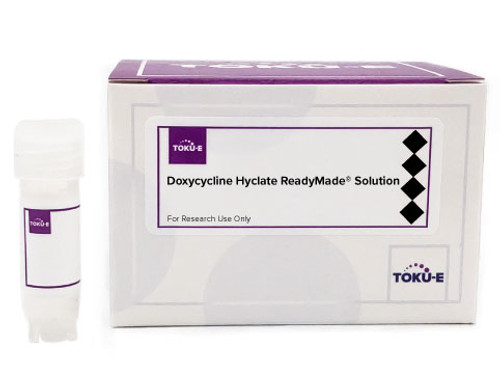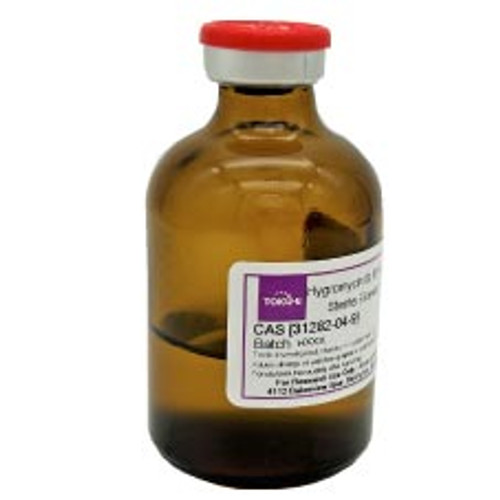Doxycycline Hyclate ReadyMade™ Solution is provided as a sterile-filtered solution formulated in DMSO at a concentration of 100 mg/ml. Doxycycline Hyclate is a broad-spectrum second generation tetracycline targeting bacteria responsible for respiratory infections. It is a matrix metalloproteinase inhibitor, an inhibitor of mitochondrial biogenesis, and it has been shown to have anti-cancer properties.
We also offer:
| Mechanism of Action | Tetracycline antimicrobials bind to the bacterial 30S ribosomal subunit interfering with tRNA/mRNA interaction, ultimately inhibiting protein synthesis. Tetracyclines can inhibit the MMP enzyme family and inhibit mitochondrial biogenesis. |
| Spectrum | Doxycycline Hyclate has broad-spectrum activity against Gram-positive and Gram-negative bacteria, and Mycoplasma (ie. M. pneumoniae). Certain β-lactam resistant strains of vancomycin resistant Enterococcus are also inhibited. |
| Microbiology Applications |
Doxycycline Hyclate is commonly used in clinical in vitro microbiological antimicrobial susceptibility tests (panels, discs, and MIC strips) against Gram-positive, Gram-negative, and certain Mycoplasma species. Medical microbiologists use AST results to recommend antibiotic treatment options. Representative MIC values include: Mycoplasma pneumoniae 0.03 µg/mL – 0.25 µg/mL |
| Eukaryotic Cell Culture Applications | Doxycycline Hyclate is routinely used for gene selection. For additional information on your cell culture needs, please visit our cell-culture database.
Doxycycline is a matrix metalloproteinase inhibitor. Using a series of in vitro assays that mimic steps in vascular remodeling, researchers found Doxyclline increased smooth muscle cell adhesion to the substrate. It also inhibited collagen gel remodeling. These properties make it potentially useful in vascular disease like atherosclerosis, restenosis, and transplant arteriopathy (Franco et al, 2006). |
| Cancer Applications | Using 12 different human tumor cell lines representing 8 different cancer types (DCIS, breast, lung, ovarian, pancreatic, prostate, glioblastoma, and melanoma), authors found that Doxyclycline inhibited cancer stem cell propagation across this entire panel of cell lines (Lamb et al, 2015).
Doxycycline can eradicate cancer stem cells in breast cancer patients in vivo. Authors found a quantitative decease in CD44 and ALDH1 expression, biomarkers of ‘stemness’. This is promising work in using cancer stem cells for cancer prevention, and is an excellent candidate for drug repurposing (Scatena C et al, 2018). |
| Molecular Formula | C22H24N2O8 · HCl · 0.5H2O · 0.5C2H6O |
| References |
Anderson MA and Gusella JF (1984) Use of Cyclosporin A in establishing Epstein-Barr virus-transformed human lymphoblastoid cell lines. In Vitro 20(11):856-858. PMID 6519667 Bardiya N and Shiu PKT (2007) Cyclosporin A-resistance based gene placement system for Neurospora crassa. Fungal Genet. Biol. 44(5):307-314 Carbajo-Lozoya J, Ma-Lauer Y, and Malesevic M (2014) Human coronavirus NL63 replication is cyclophilin A-dependent and inhibited by non-immunosuppressive cyclosporine A-derivatives including Alisporivir. Virus Res. 184:44-53 Cure E, Kucuk A and Cure MC (2020) Cyclosporine therapy in cytokine storm due to coronavirus disease 2019 (COVID-19). Rheumatol. Int. 40:1177-1179 Homan KA et al (2016) Bioprinting of 3D convoluted renal proximal tubules on perfusable chips. Sci Rep. 11(6):34845 PMID 27725720 Laupacis A et al. PA (1982) Cyclosporin A: A powerful immunosuppressant. Can. Med Assoc. J 126(9):1041-1046 PMID 7074504 Stiller, CR and Ulan RA (1981) Cyclosporin A: A powerful immunosuppressant. Can. Med. Assn. 126 (1981): 1041-046. Zhang G and Lyons JG (2002) Cyclosporin A improves the selection of cells transfected with the Puromycin acetyltransferase gene. Biotechniques, 33(1):32-36 |









